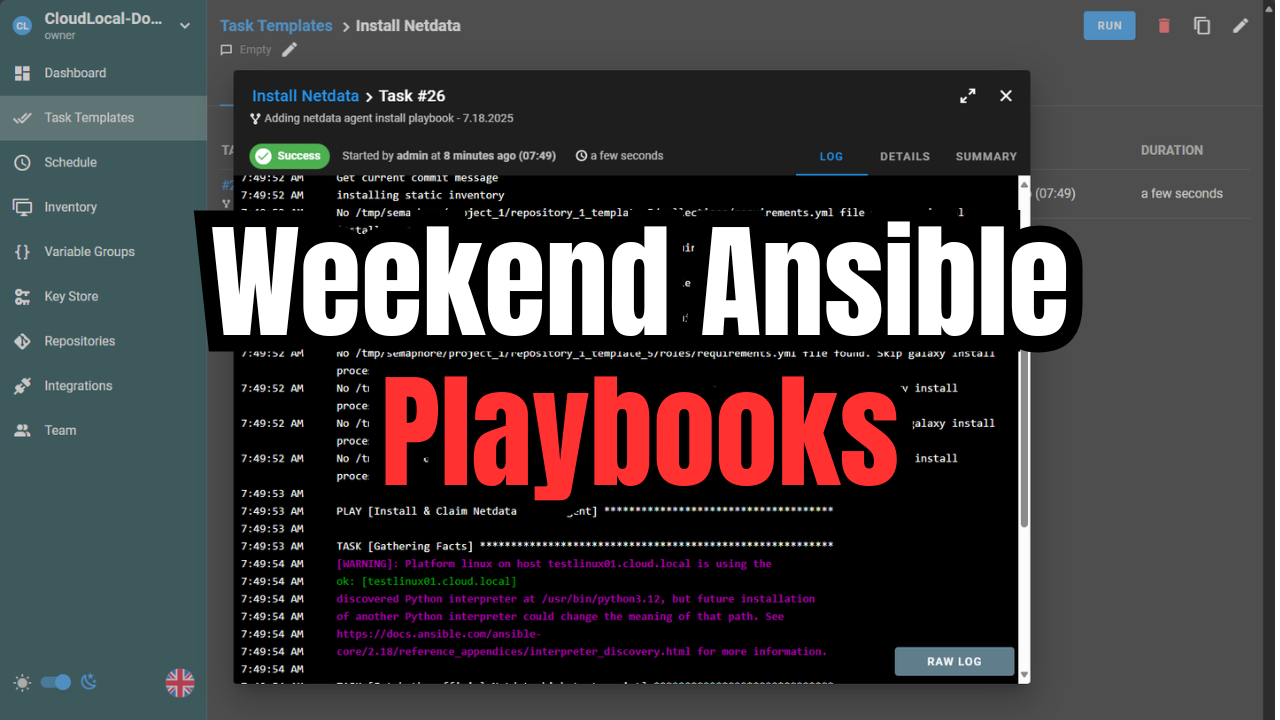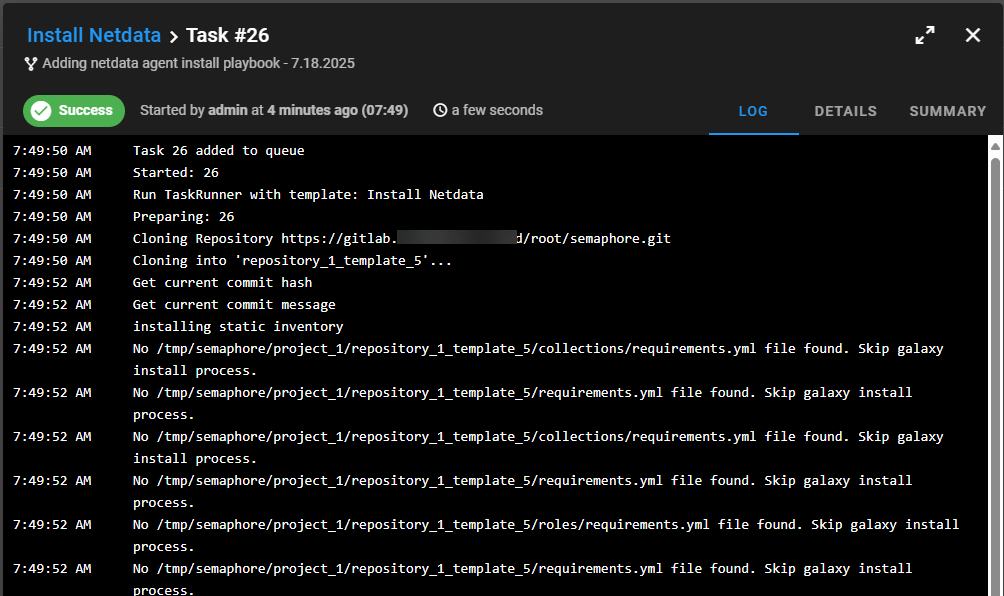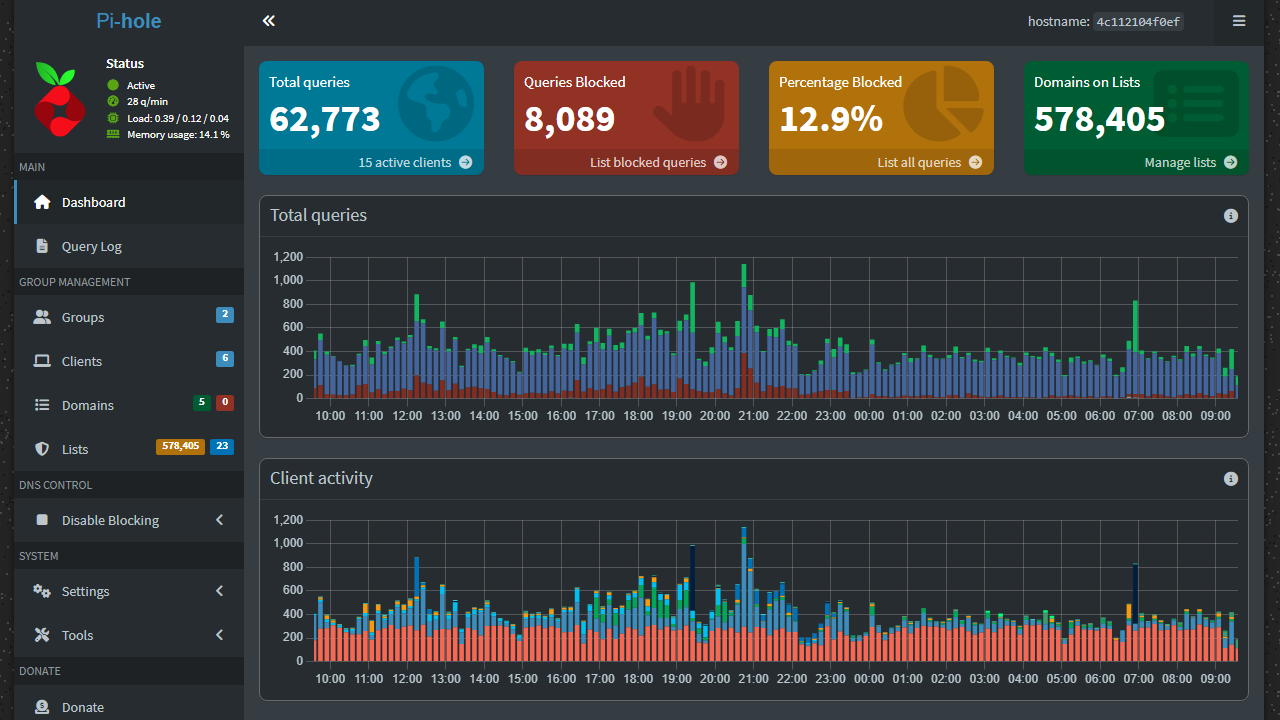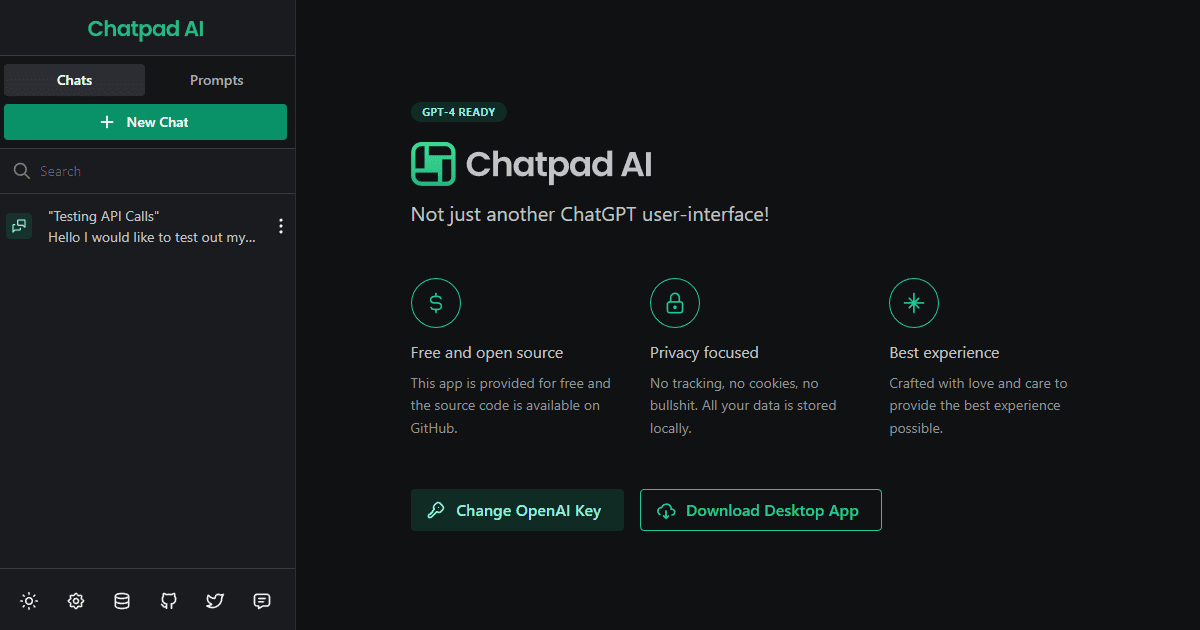I’ve spent countless weekends automating every corner of my home lab, and nothing feels better than kicking back on Monday morning knowing that routine tasks and projects in the home lab ran themselves over the weekend. In this post, I’m sharing 15 of my favorite Ansible playbooks that are weekend-ready for very cool home lab fun!
Why Ansible playbooks?
Well, in a word, they are awesome. They help to make very tedious configuration changes and configuration management in general much easier. Also, the thing that has always drawn me to Ansible is the fact that it is agentless. So, you don’t have to manage a fleet of agents across the environment. There are also great tools like Ansible Semaphore UI that I have recently written about that gives you a super nice GUI to work with your Ansible playbooks.
1. Install Docker Engine
This is a playbook that I run often when I want to make a Linux host a Docker Engine host. This installs Docker and adds the user you want to add to the Docker group. Just replace linuxadmin with the user you want to add to the Docker group.
---
- name: Install Docker and add user to docker group
hosts: all
become: true
tasks:
- name: Update apt package index and install dependencies
ansible.builtin.apt:
name:
- ca-certificates
- curl
- gnupg
update_cache: yes
state: present
- name: Create directory for Docker's GPG key
ansible.builtin.file:
path: /etc/apt/keyrings
state: directory
mode: '0755'
- name: Download and de-armor Docker's official GPG key
ansible.builtin.shell:
cmd: curl -fsSL https://download.docker.com/linux/ubuntu/gpg | gpg --dearmor -o /etc/apt/keyrings/docker.gpg
creates: /etc/apt/keyrings/docker.gpg
- name: Ensure Docker GPG key has correct permissions
ansible.builtin.file:
path: /etc/apt/keyrings/docker.gpg
mode: '0644'
- name: Set up Docker's official repository
ansible.builtin.shell:
cmd: 'echo "deb [arch=$(dpkg --print-architecture) signed-by=/etc/apt/keyrings/docker.gpg] https://download.docker.com/linux/ubuntu $(. /etc/os-release && echo "$VERSION_CODENAME") stable" | tee /etc/apt/sources.list.d/docker.list > /dev/null'
creates: /etc/apt/sources.list.d/docker.list
- name: Update apt package index after adding repo
ansible.builtin.apt:
update_cache: yes
- name: Install Docker Engine and plugins
ansible.builtin.apt:
name:
- docker-ce
- docker-ce-cli
- containerd.io
- docker-buildx-plugin
- docker-compose-plugin
state: present
- name: Create docker group
ansible.builtin.group:
name: docker
state: present
- name: Add user 'linuxadmin' to docker group
ansible.builtin.user:
name: linuxadmin
groups: docker
append: yes2. Setup NTP with Chrony
Keeping accurate time on your Linux host is extremely important. Especially for things like logs, certs, clusters, etc. The below Ansible playbook installs chrony and points it to publicly available NTP servers. Just replace the NTP servers with ones you want to use instead if you want to change them. Also, it will make sure the service is running and makes firewall changes if needed.
---
- name: Configure NTP with Chrony
hosts: all
become: yes
vars:
chrony_servers:
- 0.pool.ntp.org
- 1.pool.ntp.org
tasks:
- name: Install chrony
apt:
name: chrony
state: present
update_cache: yes
- name: Configure NTP servers
lineinfile:
path: /etc/chrony/chrony.conf
regexp: '^server'
line: "server {{ item }} iburst"
loop: "{{ chrony_servers }}"
- name: Restart chrony
service:
name: chrony
state: restarted
enabled: yes3. Edit Sudoers via visudo
Instead of having to hand edit /etc/sudoers, this playbook uses the visudo command. This approach allows you to grant passwordless sudo to your admin group or a specific user.
---
- name: Configure visudo for secure sudoers
hosts: all
become: yes
tasks:
- name: Allow admin group passwordless sudo
copy:
dest: /etc/sudoers.d/admin
content: "%{{ ansible_user }} ALL=(ALL) NOPASSWD:ALL"
owner: root
group: root
mode: '0440'
##For a specific user
---
- name: Add linuxadmin to sudoers
hosts: all
become: yes
tasks:
- name: Ensure linuxadmin can sudo without a password
lineinfile:
path: /etc/sudoers
state: present
regexp: '^linuxadmin'
line: 'linuxadmin ALL=(ALL) NOPASSWD: ALL'
validate: 'visudo -cf %s'4. Set the timezone
Going along with the earlier comment about accurate time, setting the correct timezone helps avoid confusion in logs and other things. This playbook makes sure your hosts are set to the correct timezone. Just replace with the timezone you want to use.
---
- name: Configure system timezone
hosts: all
become: yes
vars:
tz: America/Chicago
tasks:
- name: Set timezone
timezone:
name: "{{ tz }}"
5. Update your Linux server
This playbook runs updates for APT, YUM, or Zypper based on ansible_facts['pkg_mgr'], then reboots if a kernel update occurred. I like to run this playbook periodically using Ansible Semaphore against my Linux fleet to make sure everything stays up-to-date.
---
- name: Apply all Linux updates
hosts: all
become: yes
tasks:
- name: Update all packages
package:
name: "*"
state: latest
register: update_result
- name: Reboot if kernel updated
reboot:
when: update_result.changed
6. Create Linux users and deploy SSH keys
With this, you can automate your user provisioning and SSH keys so you never hand out plain-text passwords. Replace the users list with your own.
---
- name: Create users and deploy SSH keys
hosts: all
become: yes
vars:
users:
- name: alice
key: "{{ lookup('file', '~/.ssh/alice.pub') }}"
- name: bob
key: "{{ lookup('file', '~/.ssh/bob.pub') }}" - name: mydogkujo key: "{{ lookup('file', '~/.ssh/mydogkujo.pub') }}"
tasks:
- name: Create user accounts
user:
name: "{{ item.name }}"
state: present
shell: /bin/bash
loop: "{{ users }}"
- name: Add SSH authorized keys
authorized_key:
user: "{{ item.name }}"
key: "{{ item.key }}"
state: present
loop: "{{ users }}"7. UFW firewall config
This allows you to lock down network traffic to your Linux hosts. It installs UFW, sets your rules, and enables it. The below example makes sure SSH and HTTP/S are allowed.
---
- name: Configure UFW firewall
hosts: all
become: yes
tasks:
- name: Install UFW
apt:
name: ufw
state: present
update_cache: yes
- name: Allow SSH
ufw:
rule: allow
name: OpenSSH
- name: Allow HTTP & HTTPS
ufw:
rule: allow
port: "{{ item }}"
loop:
- 80
- 443
- name: Enable UFW
ufw:
state: enabled
logging: on8. Prune unused Docker images
This is also one I like to schedule and run periodically. Over time, a Docker host will get bloated with unused images, dangling containers, and other disk space wasters. The top Ansible YML code just prunes images. The bottom one prunes everything. Be careful with the bottom one as it will prune stopped containers, etc that you may not want to get rid of.
##Prune just images
---
- name: Prune unused Docker images
hosts: all
become: yes
tasks:
- name: Prune dangling images
docker_image:
prune: yes
dangling: yes
- name: Prune all unused images
command: docker image prune -a -f
args:
warn: false
##Prune images and everything else - be careful with this one
---
- name: Prune unused Docker images & everything else
hosts: all
become: yes
tasks:
- name: Prune dangling images
community.docker.docker_prune:
images: yes
dangling: yes
- name: Prune all unused Docker objects (system prune)
ansible.builtin.shell: docker system prune -a -f
args:
warn: false9. Install and configure Fail2Ban
Fail2Ban is a well-known tool to help with SSH brute force and hacking attempts. This playbook automates its setup and configuration.
---
- name: Install and configure Fail2Ban
hosts: all
become: yes
tasks:
- name: Install fail2ban
apt:
name: fail2ban
state: present
update_cache: yes
- name: Deploy jail.local
copy:
src: files/jail.local
dest: /etc/fail2ban/jail.local
owner: root
group: root
mode: '0644'
- name: Restart fail2ban
service:
name: fail2ban
state: restarted
enabled: yes10. Create Swap File
This is one for a few edge cases. On low-RAM systems, this is an automated swap file setup to prevent out-of-memory issues during heavy builds.
---
- name: Create swap file if not present
hosts: all
become: yes
vars:
swap_file: /swapfile
swap_size_mb: 2048
tasks:
- name: Allocate swap file
command: fallocate -l {{ swap_size_mb }}M {{ swap_file }}
args:
creates: "{{ swap_file }}"
- name: Secure swap file
file:
path: "{{ swap_file }}"
owner: root
mode: '0600'
- name: Make swap
command: mkswap {{ swap_file }}
- name: Enable swap
command: swapon {{ swap_file }}
- name: Ensure swap on reboot
mount:
name: none
src: "{{ swap_file }}"
fstype: swap
opts: sw
state: present11. Configure SNMP for monitoring
SNMP can be a beast to configure manually. This playbook helps you to easily integrate your Linux host with Prometheus, Zabbix, or other SNMP-based tools and automates the config of SNMPd.
---
- name: Configure SNMP service
hosts: all
become: yes
vars:
community: labpublic
tasks:
- name: Install snmpd
apt:
name: snmpd
state: present
update_cache: yes
- name: Configure community string
lineinfile:
path: /etc/snmp/snmpd.conf
regexp: '^rocommunity'
line: "rocommunity {{ community }}"
- name: Restart snmpd
service:
name: snmpd
state: restarted
enabled: yes
12. Deploy a basic Nginx web server
This playbook helps to quickly get Nginx installed and loaded with a basic configuration on your Linux server to serve out a static page on port 80.
---
- name: Install and configure Nginx
hosts: all
become: yes
tasks:
- name: Install nginx
apt:
name: nginx
state: present
update_cache: yes
- name: Deploy index.html
copy:
src: files/index.html
dest: /var/www/html/index.html
owner: www-data
group: www-data
mode: '0644'
- name: Ensure nginx is running
service:
name: nginx
state: started
enabled: yes13. Backup /etc to a Remote Host
On a traditional VM or server, if you need to get a backup of host level configuration in the /etc directory, this playbook helps to automate daily backups of /etc via rsync to a central server. It keeps a 7-day rotation.
---
- name: Backup /etc directory
hosts: all
become: yes
vars:
backup_host: backup.lab.local
backup_path: /backups/{{ inventory_hostname }}
tasks:
- name: Create remote backup directory
file:
path: "{{ backup_path }}"
state: directory
mode: '0755'
delegate_to: "{{ backup_host }}"
- name: Rsync /etc
synchronize:
src: /etc/
dest: "{{ backup_path }}/etc-{{ ansible_date_time.date }}"
archive: yes
delete: no
14. Install and configure PostgreSQL
PostgreSQL is one of the most popular DB solutions, especially on Linux environments and backs many different solutions for backend data. This playbook helps to stand up a secure database, adding a user and database you configure.
---
- name: Install and configure PostgreSQL
hosts: all
become: yes
vars:
db_user: labuser
db_name: labdb
db_password: secure_pass_here
tasks:
- name: Install PostgreSQL
apt:
name: postgresql
state: present
update_cache: yes
- name: Ensure postgres is running
service:
name: postgresql
state: started
enabled: yes
- name: Create database user
postgresql_user:
name: "{{ db_user }}"
password: "{{ db_password }}"
state: present
- name: Create database
postgresql_db:
name: "{{ db_name }}"
owner: "{{ db_user }}"
encoding: UTF815. Install your Netdata agent
If you use Netdata to monitor your homelab (great option if you don’t know about it and they have a $90 a year subscription for home labs for unlimited nodes), this playbook automates onboarding your Linux server into the Netdata cloud environment. Just enter your claim token and claim room id.
---
- name: Install & Claim Netdata Cloud Agent
hosts: all
become: true
vars:
netdata_kickstart: "/tmp/netdata-kickstart.sh"
netdata_stable: true
netdata_claim_token: "your claim token"
netdata_claim_rooms: "your claim room id"
netdata_claim_url: "https://app.netdata.cloud"
tasks:
- name: Fetch the official Netdata kickstart script
ansible.builtin.get_url:
url: "https://get.netdata.cloud/kickstart.sh"
dest: "{{ netdata_kickstart }}"
mode: '0755'
register: fetched
- name: Run Netdata kickstart installer with Cloud claim
ansible.builtin.command: >
"{{ netdata_kickstart }}"
{% if netdata_stable %}--stable-channel{% endif %}
--claim-token {{ netdata_claim_token }}
--claim-rooms {{ netdata_claim_rooms }}
--claim-url {{ netdata_claim_url }}
args:
creates: /usr/sbin/netdata
when: fetched.changed
- name: Ensure Netdata service is enabled and running
ansible.builtin.service:
name: netdata
enabled: true
state: startedWrapping up
Hopefully these 15 Ansible playbooks will give you a good start on a few things to automate in your home lab environment and can be a great weekend project. With Ansible, the sky is the limit and you can develop and use Ansible scripts that are specific to your needs in the home lab and things you want to accomplish with automation.
Google is updating how articles are shown. Don’t miss our leading home lab and tech content, written by humans, by setting Virtualization Howto as a preferred source.





